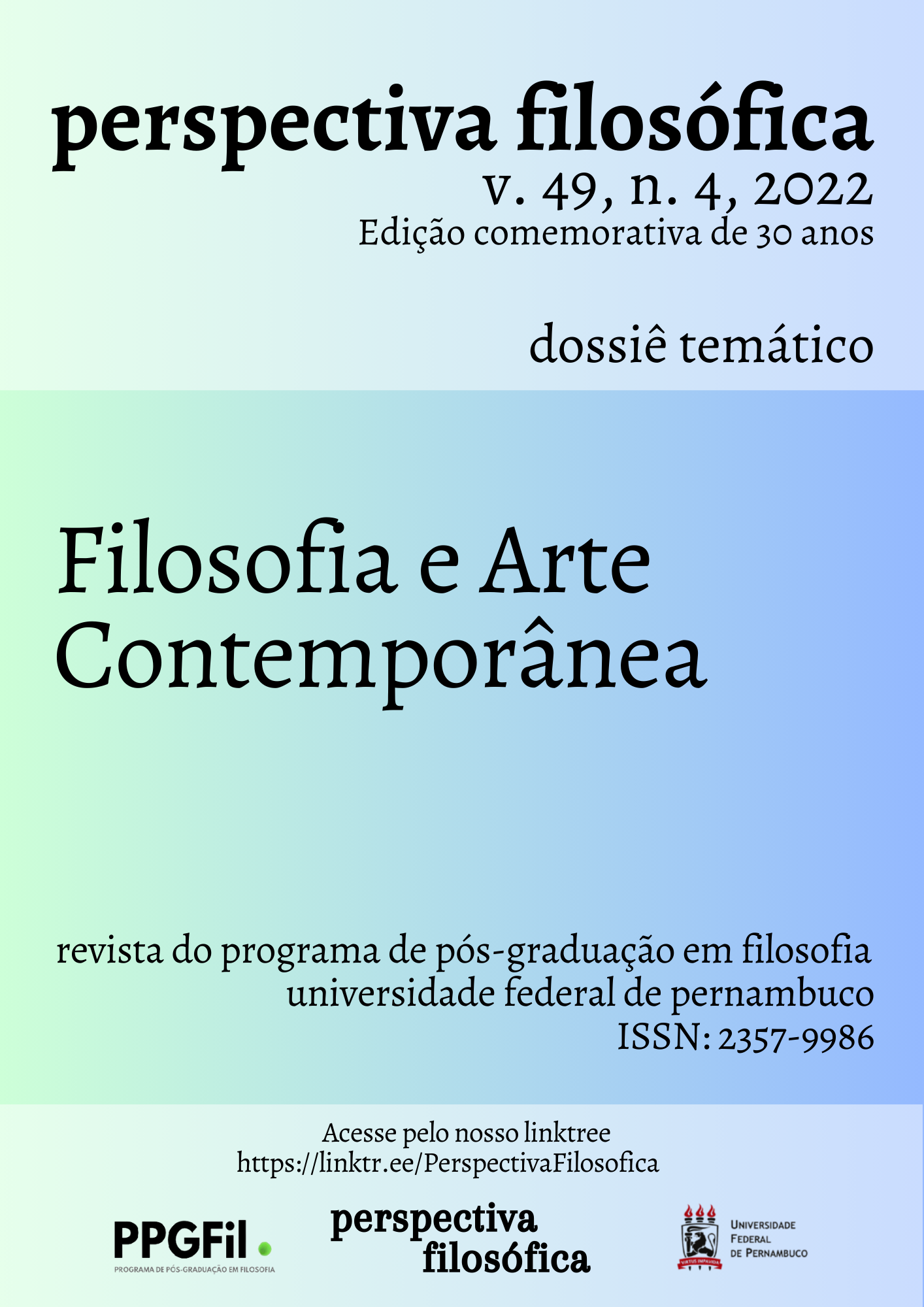More real than reality? Heidegger and Cavell on film's powers of absorption
DOI:
https://doi.org/10.51359/2357-9986.2022.256179Keywords:
skepticism, world as picture, technology, Heidegger, CavellAbstract
The power of (still and moving) pictures to absorb us sometimes makes them feel more real than reality. Following in the footsteps of Martin Heidegger and Stanley Cavell, this paper tries to make historical and philosophical sense of that feeling, tracing it back to epochal changes in our experience that started with the advent of modernity. After highlighting the implications and costs of those changes I point to alternative ways of relating to reality which are still available to us, and argue that (some) films can help open them up.References
ABBOTT, Matthew. Abbas Kiarostami and Film-Philosophy. Edinburgh: Edinburgh University Press, 2016.
BAUDRILLARD, Jean. The Perfect Crime. Tradução: Chris Turner. London / New York: Verso Books,1996.
BAZIN, André. What Is Cinema? Vol. 1. Hugh Gray (trans.). Berkeley and Los Angeles: University of California Press, 1967.
BENJAMIN, Walter. Selected Writings: 1935-1938. Cambridge, MA: Harvard University Press, 1996.
BENJAMIN, Walter. One-Way Street. Tradução: Edmund Jephcott. Cambridge, MA: Harvard University Press, 2016. Disponível em: http://ebookcentral.proquest.com/lib/nyulibrary-ebooks/detail.action?docID=4510802. Acesso em 14 Abr. 2021.
BORGMANN, Albert. Crossing the Postmodern Divide. Chicago and London: The University of Chicago Press, 1993.
CAVELL, Stanley. Must We Mean What We Say?, Cambridge: Cambridge University Press, 1976.
CAVELL, Stanley. The World Viewed: Reflections on the Ontology of Film (Enlarged Edition). Cambridge, MA: Harvard University Press, 1979.
CAVELL, Stanley (1987). Disowning Knowledge: In Six Plays of Shakespeare. Cambridge: Cambridge University Press.
KELLNER, Douglas. “Jean Baudrillard”. The Stanford Encyclopedia of Philosophy, Winter 2020 Edition, Edward N. Zalta (ed.), 2020. Disponível em: https://plato.stanford.edu/archives/win2020/entries/baudrillard/. Acesso em Abr. 2021.
KISIEL, Theodor. “Heidegger and Our Twenty-first Century Experience of Ge-Stell”. In: B. Babich and D. Ginev (eds.), The Multidimensionality of Hermeneutic Phenomenology, Contributions to Phenomenology 70, DOI 1007/978-3-319-01707-5_9 Switzerland: Springer International Publishing, 2014.
LOHT, Shawn. “Film as Heideggerian Art? A Re-Assessment of Heidegger, Film, and His Connection to Terrence Malick.” In: Film and Philosophy 17: p. 113-36, 2013.
LOHT, Shawn. Phenomenology of Film: A Heideggerian Account of the Film Experience. Lanham, MD: Lexington Books, 2017.
MOSELY, Michael Josiah. “Another Look at Heideggerian Cinema: Cinematic Excess, Antonioni's Dead Time and the Film-Photographic Image as Copy”. In: Film-Philosophy 22:3, pp. 364-383, 2018.
ROJCEWICZ, Richard. The Gods and Technology: A Reading of Heidegger.
Albany, NY: State University of New York Press, 2006.
SINNERBRINK, Robert. “Techne and Poiesis: On Heidegger and Film Theory”. In A. van den Oever (Ed.), Techne/Technology: Researching Cinema and Media Technologies – Their Development, Use, and Impact (pp. 65–. Amsterdam: Amsterdam University Press, 2014.
SONTAG, Susan. On Photography. New York: Farrar, Straus and Giroux,
RUSHTON, Richard. The reality of film: Theories of filmic reality. Manchester and New York: Manchester University Press, 2011.
HEIDEGGER, Martin. Discourse on Thinking. Tradução: John M. Anderson e E. Hans Freund. New York: Harper & Row, 1966.
HEIDEGGER, Martin. What Is Called Thinking? Tradução: J. Glenn Gray e Fred D. Wieck. New york: Harper Torchback, 1972.
HEIDEGGER, Martin. The Question concerning Technology, and Other Essays. New York: Harper & Row, 1977.
HEIDEGGER, Martin. On the Way to Language. Tradução: P. D. Hertz. New York: Harper & Row, 1982.
HEIDEGGER, Martin. An Introduction to Metaphysics. Tradução: Gregory Fried e Richard Polt. New Haven: Yale University Press, 2000.
HEIDEGGER, Martin. Poetry, Language, Thought. Tradução: Albert Hofstadter. New York: HarperCollins, 2001.
HEIDEGGER, Martin. Off the Beaten Track. Cambridge, MA: Cambridge University Press, 2002.
HEIDEGGER, Martin. Heraclitus: The Inception of Occidental Thinking and Logic: Heraclitus’s Doctrine of the Logos. Tradução: Julia Goesser Assaiante e S. Montgomery Ewegen. London and New York: Bloomsbury Publishing, 2018.
TECHIO, Jônadas. “Can film show what (analytic) philosophy won't say? The “film as philosophy” debate, and a reading of Rashomon”. Revista Dissertatio de Filosofia, v. 6, p. 69-105, 2018.
TECHIO, Jônadas. “The world viewed and the world lived: Stanley Cavell and film as the moving image of skepticism”. In: Christina Rawls, Diana Neiva, Steven S. Gouveia (Eds.), Film and Philosophy: Bridging Divides. Routledge, 2019.
TECHIO, Jônadas. “Mourning the Loss of the Ordinary: A Cavellian Reading of Ozu's Late Spring”. Aesthetic Investigations, v. 3, 2020.
WITTGENSTEIN, Ludwig. The Blue and Brown Books. Oxford: Basil Blackwell, 1958.
WOESSNER, Martin. “What Is Heideggerian Cinema? Film, Philosophy, and Cultural Mobility”. In New German Critique 113, Vol. 38, No. 2, Summer 2011.
Downloads
Published
Issue
Section
License
A Revista Perspectiva Filosófica orienta seus procedimentos de gestão de artigos conforme as diretrizes básicas formuladas pelo Conselho Nacional de Desenvolvimento Científico e Tecnológico (CNPq). http://www.cnpq.br/web/guest/diretrizesAutores que publicam nesta revista concordam com os seguintes termos:
Os autores mantém os direitos autorais e concedem à revista o direito de primeira publicação, sendo o trabalho simultaneamente licenciado sob https://creativecommons.org/licenses/by/4.0/deed.pt_BR que permite o compartilhamento do trabalho com reconhecimento da autoria e publicação inicial nesta revista.
Os autores têm autorização para assumir contratos adicionais separadamente, para distribuição não-exclusiva da versão do trabalho publicada nesta revista, com reconhecimento de autoria e publicação inicial nesta revista (Consultar http://opcit.eprints.org/oacitation-biblio.html).

Esta revista está licenciada com uma Licença Creative Commons Atribuição 4.0 Internacional.













